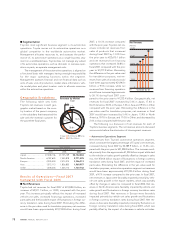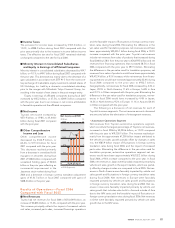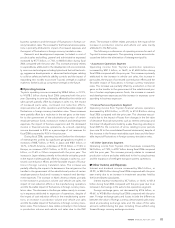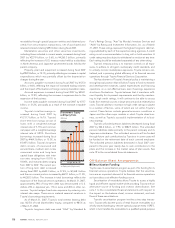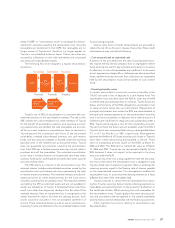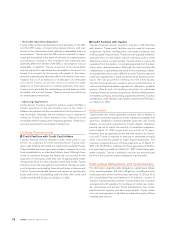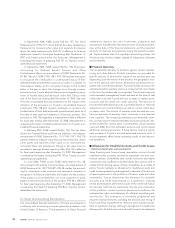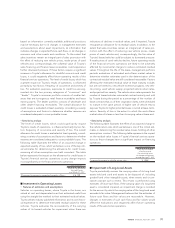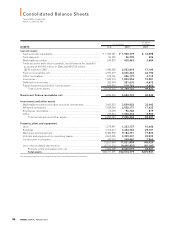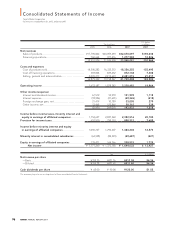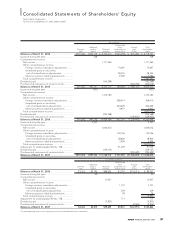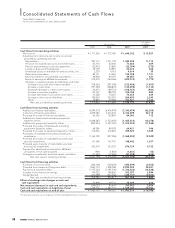Toyota 2007 Annual Report Download - page 90
Download and view the complete annual report
Please find page 90 of the 2007 Toyota annual report below. You can navigate through the pages in the report by either clicking on the pages listed below, or by using the keyword search tool below to find specific information within the annual report.
• Receivable repurchase obligations
Toyota makes certain representations and warranties to the SPE,
and the SPE makes corresponding representations and war-
ranties to the securitization trust, relating to receivables sold in a
securitization. Toyota and the SPE may be required to repur-
chase any receivables in the event of a breach of a representation
and warranty relating to the receivable that materially and
adversely affects the interest of the SPE, or securitization trust, as
applicable. In addition, Toyota, as servicer of the receivables,
may be required to repurchase any receivable in the event of a
breach of a covenant by the servicer with respect to the receiv-
able that materially and adversely affects the interest of the secu-
ritization trust or of an extension or modification of a receivable
as to which Toyota, as servicer, does not commit to make
advances to fund reductions in interest payments. The repur-
chase price is generally the outstanding principal balance of the
receivable and accrued interest. These provisions are customary
for securitization transactions.
• Advancing requirements
As the servicer, Toyota is required to advance certain shortfalls in
obligor payments to the securitization trust to the extent it
believes the advance will be recovered from future collections of
that receivable. Generally, the securitization trust is required to
reimburse Toyota for these advances from collections on all
receivables before making other required payments. These provi-
sions are customary for securitization transactions.
Lending Commitments
■Credit Facilities with Credit Card Holders
Toyota’s financial services operation issues credit cards to cus-
tomers. As customary for credit card businesses, Toyota main-
tains credit facilities with holders of credit cards issued by Toyota.
These facilities are used upon each holders’ requests up to the
limits established on an individual holder’s basis. Although loans
made to customers through this facility are not secured, for the
purposes of minimizing credit risks and of appropriately estab-
lishing credit limits for each individual credit card holder, Toyota
employs its own risk management policy which includes an analy-
sis of information provided by financial institutions in alliance with
Toyota. Toyota periodically reviews and revises, as appropriate,
these credit limits. Outstanding credit facilities with credit card
holders were ¥2,519.5 billion as of March 31, 2007.
■Credit Facilities with Dealers
Toyota’s financial services operation maintains credit facilities
with dealers. These credit facilities may be used for business
acquisitions, facilities refurbishment, real estate purchases, and
working capital requirements. These loans are typically collateral-
ized with liens on real estate, vehicle inventory, and/or other
dealership assets, as appropriate. Toyota obtains a personal
guarantee from the dealer or corporate guarantee from the deal-
ership when deemed prudent. Although the loans are typically
collateralized or guaranteed, the value of the underlying collater-
al or guarantees may not be sufficient to cover Toyota’s exposure
under such agreements. Toyota prices the credit facilities accord-
ing to the risks assumed in entering into the credit facility.
Toyota’s financial services operation also provides financing to
various multi-franchise dealer organizations, referred to as dealer
groups, often as part of a lending consortium, for wholesale
inventory financing, business acquisitions, facilities refurbishment,
real estate purchases, and working capital requirements. Toyota’s
outstanding credit facilities with dealers totaled ¥1,637.9 billion
as of March 31, 2007.
Guarantees
Toyota enters into certain guarantee contracts with its dealers to
guarantee customers’ payments of their installment payables that
arise from installment contracts between customers and Toyota
dealers, as and when requested by Toyota dealers. Guarantee
periods are set to match the maturity of installment payments,
and at March 31, 2007 range from one month to 35 years.
However, they are generally shorter than the useful lives of prod-
ucts sold. Toyota is required to execute its guarantee primarily
when customers are unable to make required payments. The
maximum potential amount of future payments as of March 31,
2007 is ¥1,333.9 billion. Liabilities for these guarantees of ¥3.6 bil-
lion have been provided as of March 31, 2007. Under these guar-
antee contracts, Toyota is entitled to recover any amounts paid
by it from the customers whose obligations it guaranteed.
Contractual Obligations and Commitments
For information regarding debt obligations, capital lease obliga-
tions, operating leases, and other obligations, including amounts
maturing in each of the next five years, see notes 13, 22 and 23 to
the consolidated financial statements. In addition, as part of
Toyota’s normal business practices, Toyota enters into long-term
arrangements with suppliers for purchases of certain raw materi-
als, components and services. These arrangements may contain
fixed/minimum quantity purchase requirements. Toyota enters
into such arrangements to facilitate an adequate supply of these
materials and services.
88 ANNUAL REPORT 2007


